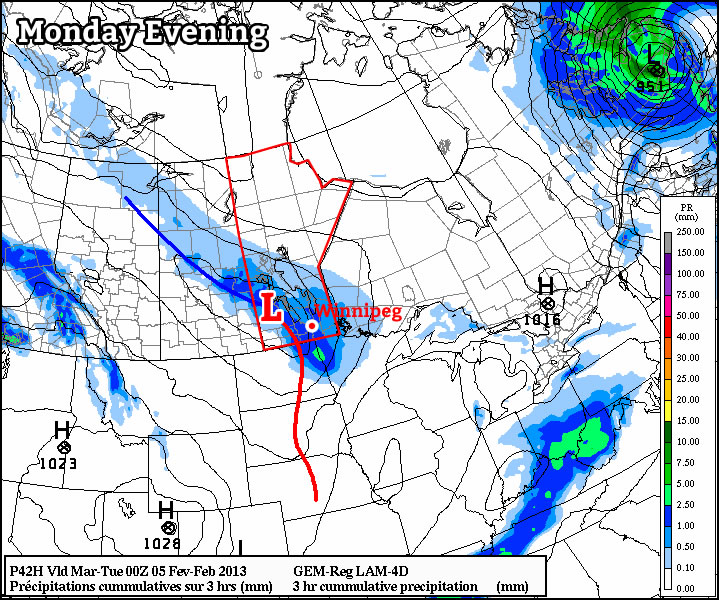Warmer weather will be more common in Southern Manitoba this week, but that’s not to say it will be warm weather. Rather, it will just feel warm relative to the arctic weather we’ve experienced lately.

The weather this week will be characterized by a semi-zonal flow aloft. A zonal flow is when the jet stream moves west to east, which tends to give us neither really cold weather nor really warm weather. A series of small disturbances will ride along the jet stream, bringing us a couple chances for snow through the early part of the week.
Monday
Light Snow
-12°C / -17°C
An Alberta Clipper system will roll through Southern Manitoba on Monday bringing more snow along with it. This will be a fairly weak clipper, without much moisture to work with. At this point it looks like the “heaviest” band of snow will pass somewhat south and west of Winnipeg, where up to about 5cm could fall. In Winnipeg and area amounts will in the 2-4cm range. There won’t be much in the way of wind with this system, so its affects will be limited to adding more slippery sections to roadways.
Tuesday
Mainly Cloudy
-10°C / -15°C
Tuesday will be a fairly nice day overall, with light winds and mainly cloudy skies. Temperatures will be fairly close to seasonal values, with highs in the upper single digits or lower double digits (below zero of course).
Wednesday
Snow
-7°C / -18°C
It appears that we’ll see yet another Alberta Clipper on Wednesday. It will bring snow once again, with accumulations probably being a bit higher than those seen on Monday. It’s hard to say exactly how much we might get from this clipper, but an early guess would be anywhere from 4 to 8cm in Southern Manitoba. Check the comments for an updated forecast for Wednesday over the next couple days.
For once there may be something of interest to talk about in the long-range. There have been numerous indications over the past week that we may be heading toward a more prolonged warm period that could exist through mid-February. The Climate Prediction Centre, NAEFS ensemble, ECMWF, and arctic oscillation predictions are all in line with milder weather for the early to mid-month period. They don’t give a clear indication of how mild it could get, but certainly arctic outbreaks like those experienced in January could be much harder to come over the next while.



